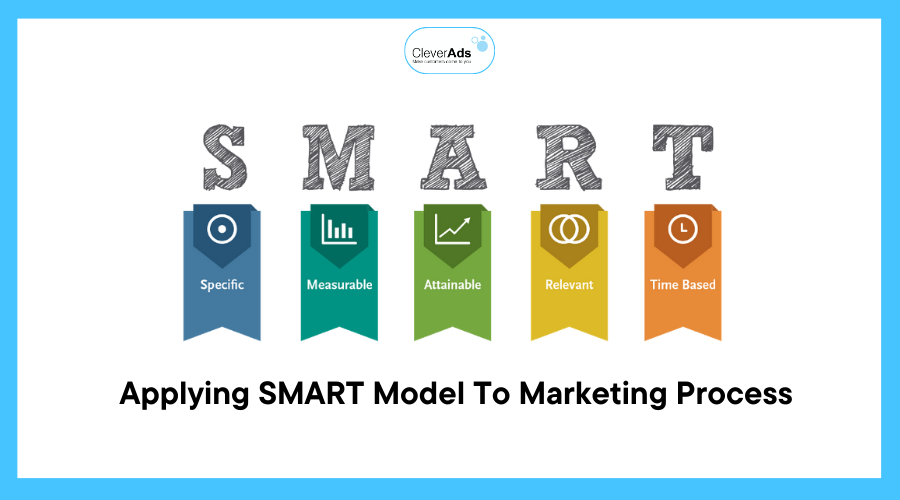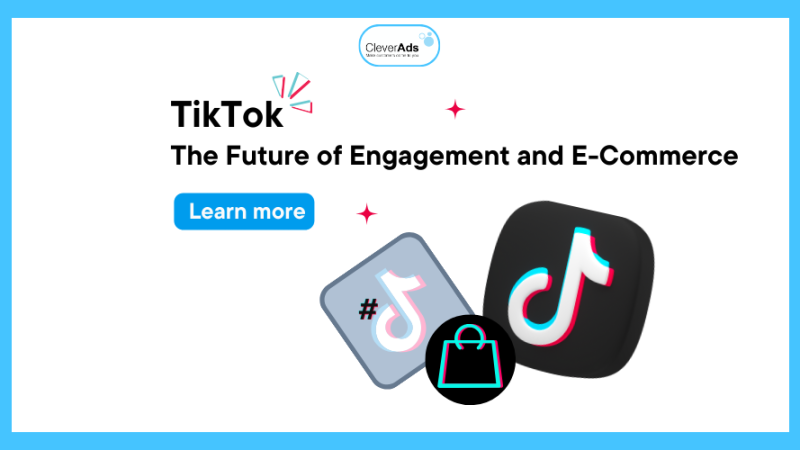Applying SMART model to effective marketing process

The better way to build an effective marketing plan is to use the SMART model. SMART is an acronym for Specific, Measurable, Achievable, Realistic, and Timely. If you develop and deliver your company’s goals to fully meet these requirements, your marketing plan has a better chance of succeeding. So let’s learn with CleverAds how to apply the SMART model to your business’ sales goals optimally.
1. What is SMART marketing objective?
SMART marketing goals are goals established using the SMART framework to help us avoid these situations, set-up clear goals and objectives, and align expectations:
1.1 Set specific goals
The marketing team needs to know what the goal is. Understanding means knowing what they need to achieve and how to get there.
Therefore, the goals must be clearly outlined and as precise as possible. There is no space for ambiguity or open language for multiple interpretations here.
- Here is an example of a non-specific goal:
Improved content performance by 15% this quarter.
Just saying “content” is not specific enough.
- Instead, try:
Improved Marketing Qualified Lead generation across all blog posts by 15% this quarter.
1.2 Make goals measurable
Setting measurable goals means understanding the metrics you’ll be tracking and how you’ll determine the success or failure of your campaign. Measuring success or failure is crucial because it allows you to track your progress, evaluate what works well, and modify it accordingly.
Therefore, you must establish key performance indicators (KPIs) and benchmarks, and communicate these to your team.
1.3 Make goals achievable
By all means, set the bar high for your team, but make sure your goals stay within the realistic range. You don’t want goals that are too easy, and not challenging enough to motivate the team, but you also don’t want them to be so difficult that people get frustrated.
It’s best to seek everyone’s input on whether a goal is achievable before completing it.
You must also take into account factors such as free time, vacation time, and project budget.
1.4 Make the goals relevant
The project and campaign goals of the marketing team should be related to your company goals as a whole. Confirm that you effectively communicate your company vision so that your team understands the primary purpose behind each objective and campaign.
-
For example:
Imagine your company wants to increase sales by 20% annually. Your marketing team goals might be to attract 20% more qualified leads to help achieve that overall goal. Marketing goals are directly related to the company’s larger mission.
1.5 Set time-limited goals
Goals must have a deadline. Without one, you run the risk of your team feeling disoriented and possibly even slacking off due to a perceived lack of urgency. Creating campaign progress will help you determine if you’re on track to achieve your goal (or not). If things start to lag, you can adjust your strategy accordingly.
Your deadlines, like goals, should be realistic and realistic. Ask your team if they can deliver within the desired timeframe. Remember that your timeline should also align with the company’s timeline.
If you want to track how long different steps are taking and how much time each team member spends on a project, you can use a timesheet app to do it.
2. Benefits of setting SMART goals in Marketing
Why invest time in SMART marketing goals?
2.1 Increased clarity
If you stop with the example of a simple objective plan to increase blog traffic. Your Marketing team will be confused: Why is it important? Is there a deadline? How do you know when it’s successful?
Meanwhile, increased transparency and clarity is one of the substantial benefits of SMART goals. So when only about half of employees know what they are doing and what purpose it serves in their marketing strategy, this level of specificity is crucial.
2.2 Motivation
When you and your team have a comprehensible understanding of the task and the deadline to complete it, you will generally be more motivated to keep trying to pursue your marketing strategy. On the other hand, one study found that writing down goals makes you more likely to control and achieve them.
2.3 Prioritize better
As you go through the process of setting SMART Marketing goals, you need to make sure that your objectives meet various criteria. Not only will this help you create better ideas, but it can also serve as an accurate test of which goals are worth pursuing.
In short, setting SMART goals requires more specific, vivid, and relevant elements than throwing an indistinct finish line at the doer, so it’s easier to think through and chart your course effort direction.
3. Guide to setting SMART goals for Marketing campaigns?
One of the biggest challenges you face when setting SMART goals make sure they are realistic with each section – especially success metrics and deadlines.
You can’t predict the future, so how can you feel confident that your goals are achievable? Especially when things are always changing and there are never any guarantees.
So you have to rely on the data at hand: From past performance metrics and marketing management analytics to timelines from previous projects, you can have a wealth of information available to you. you can use to inform your upcoming goals – instead of guessing.
Also, you need to talk to your team members, connect with them and gather insights. They’re the ones doing the bulk of the work, so they’ll be able to do a reality check on your goals.
You can set a goal to motivate your team, but it shouldn’t be so lofty that it discourages them. Consider setting two SMART goals: a conventional goal and a long-term goal.
Remember that goal setting is a learning process. As you set more SMART marketing goals, you’ll discover more about what’s achievable for your team – and that’s information you should use when setting future goals.
4. How to measure and monitor SMART goals
Setting marketing goals is just the beginning. Once you have your objectives, you and your marketing team are needed to work toward them.
It is important to frequently observe your progress towards your goals:
- A simple tip is to set up a regular meeting where you and your team can connect on marketing progress. This subscription frequency will vary depending on how long it takes to reach your goal, but the bottom line is that you shouldn’t start a campaign and only discuss performance once you’ve reached the end date.
- If you have a large marketing goal, it helps to break it down into smaller milestones – this makes you feel more manageable and makes it easier to spot if you’re going off track. direction. For example, if you aim to grow your email list by 20,000 by the end of the year, you should add about 5,000 subscribers per quarter.
- Tracking and measuring your goals is easier if you have the right technology with you. Look for a project management platform (like Wrike) that gives you the insights you need to effectively track project progress and performance.
5. SMART Marketing Goal Example
Sometimes an example is the best way to clarify what a SMART marketing objective looks like.
For example:
- Drive more free trial signups by increasing your social media ad click-through rate by 3% later this month.
- Improve organic reach by ranking in the first three search results for five relevant keywords at the end of the year.
- Redesign blog to increase average time per page by 30 seconds next quarter
Enhance our reputation by planning and hosting five webinars on relevant topics this calendar year.
Remember these are just a few examples to get you started – there are several other SMART marketing goal examples you can come up with on your own.
6. Marketing objective from the SMART model
Two of the biggest challenges companies like Coca-Cola face in today’s business market are:
- Set high, but unrealistic and hard-to-achieve goals in the Consumer/Non-cyclic industry.
- Setting the bar too low, leading to inadequate use of resources in the Coca-Cola disposal process.
To overcome both of these scenarios, we recommend Coca-Cola use a SMART targeting strategy.
-
Specifically | What are the specific goals in SMART analysis / SMART Framework
Many of Coca-Cola’s timelines are based on the organization’s vision statement, resulting in broad and vague goals. Analyzing Coca-Cola’s goals can help managers achieve the following specific objectives:
- Increase revenue and profit over the next three quarters.
- Increase sales for the next three quarters by 30% year over year.
- Increase sales by 30% from last year’s sales in the same period by increasing the advertising budget.
- Increase sales of similar stores by 30% in a specific time using a similar advertising budget.
Specific goals help narrow down the overall objectives to micro-goals. Second, it will provide a clear set of objectives for different parts of the organization.
-
Measurable – What are the measurable goals in SMART Analysis / SMART Framework?
What to measure and how to measure are the two main components of SMART analysis. Metrics often define not only the KPIs of the goals but also the culture of the organization. Managers at Coca-Cola need to decide on metrics carefully because wrong measurements can lead to undesirable consequences.
The focus on click-through rates in the social media business has led to a proliferation of fake and sensational content, which is now creating legislative hurdles and consumer backlash.
Coca-Cola needs to focus on metrics that align with the values and interests of broader stakeholders.”
-
Attainable | What does achievable or achievable goal mean in SMART Analysis / SMART Framework
Some of the questions that managers at Coca-Cola ask regarding the ability to achieve the goals set in the Beverage industry are:
Does Coca-Cola have the resources to achieve its goals in terms of both financial resources and infrastructure?
Is the workforce at Coca-Cola trained enough to achieve the goals?
-
Reality | Setting realistic goals in SMART analysis / What is the SMART Framework?
According to the actual analysis, managers at Coca-Cola should focus on the scope and timeline of the project. Realistic goals are important because if the goals are not realistic then employees at Coca-Cola will lose motivation to achieve the goals. Managers at all levels of Coca-Cola should solicit employee feedback on a basis to set realistic goals.
If the goals are not realistic, employees will lose confidence in Coca-Cola’s top management.
-
Time Limit – What is a time limit in SMART Analysis / SMART Framework
Going overtime limits often leads to – increased financial costs, damage to the organization’s brand, staff layoffs, and a decline in customer confidence.
The goals set by Coca-Cola need to be concretized little by little. The project must have specific end data, for example, 3 months or 90 days. Second, each activity in the project should also be mapped based on the activity’s start time and the activity’s duration.
Read more: What is Wi-Fi Marketing? 5 effective Wi-Fi marketing strategy
7. Conclusion
Above is a general overview of the SMART model as well as ways to build a specific goal that Cleverads has synthesized for you.
Setting goals as detailed and logical as this model will help you determine the right direction in personal development.
Hopefully, marketers, understanding and applying the most effective SMART model examples at work will help you to be more complete in the business marketing process, and identify the appropriate goals with the operational strategy. of the enterprise.


